University of Technology Sydney: Nursing Leadership Essay
VerifiedAdded on 2022/09/28
|14
|3000
|19
Essay
AI Summary
This essay examines the multifaceted aspects of nursing leadership and its impact on professional practice, using a case study of a newly graduated nurse, Kim, facing challenges within a hospital setting. The essay applies Gibbs' model of reflection to analyze the situation, focusing on description, feelings, evaluation, analysis, conclusions, and action plans. It explores the effects of workplace stress, communication breakdowns, and the importance of clinical leadership skills for new nurses. Furthermore, it delves into strategies for building personal and professional resilience, emphasizing the need for support, self-care, and proactive measures to prevent similar issues. The essay concludes with a call for improved support systems and the promotion of collaborative teamwork to enhance the development of new nurses' skills and overall well-being within the healthcare environment.
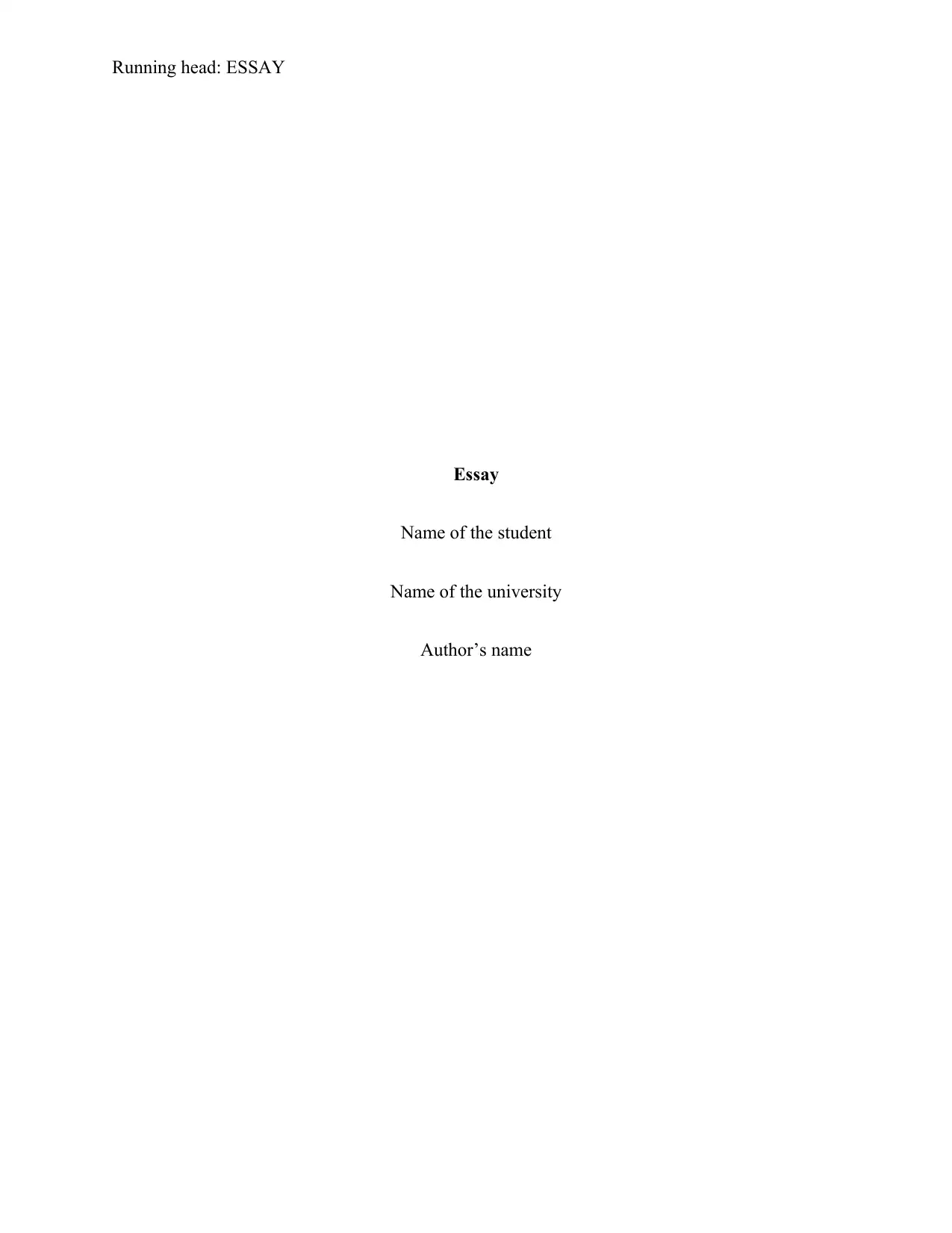
Running head: ESSAY
Essay
Name of the student
Name of the university
Author’s name
Essay
Name of the student
Name of the university
Author’s name
Paraphrase This Document
Need a fresh take? Get an instant paraphrase of this document with our AI Paraphraser
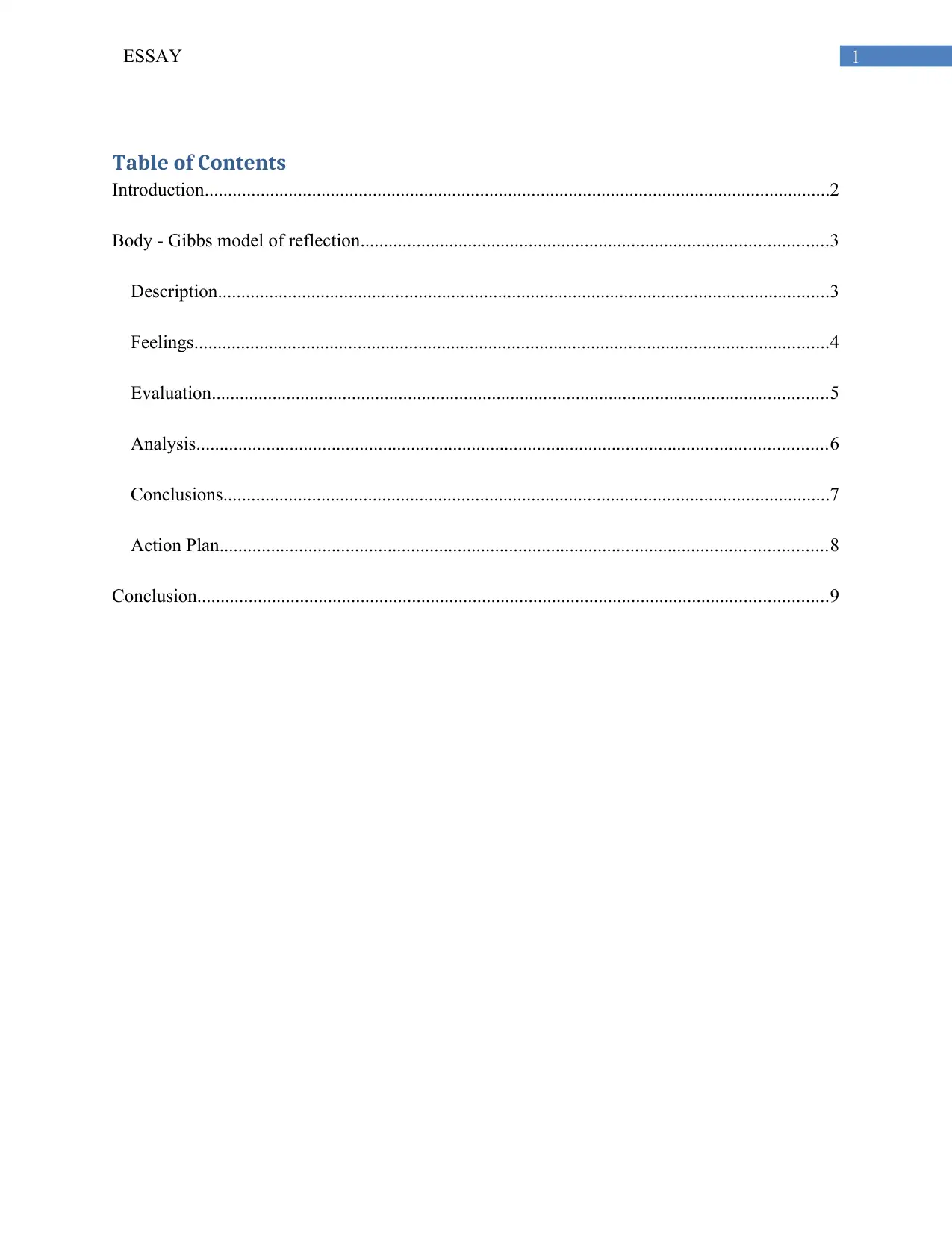
1ESSAY
Table of Contents
Introduction......................................................................................................................................2
Body - Gibbs model of reflection....................................................................................................3
Description...................................................................................................................................3
Feelings........................................................................................................................................4
Evaluation....................................................................................................................................5
Analysis.......................................................................................................................................6
Conclusions..................................................................................................................................7
Action Plan..................................................................................................................................8
Conclusion.......................................................................................................................................9
Table of Contents
Introduction......................................................................................................................................2
Body - Gibbs model of reflection....................................................................................................3
Description...................................................................................................................................3
Feelings........................................................................................................................................4
Evaluation....................................................................................................................................5
Analysis.......................................................................................................................................6
Conclusions..................................................................................................................................7
Action Plan..................................................................................................................................8
Conclusion.......................................................................................................................................9
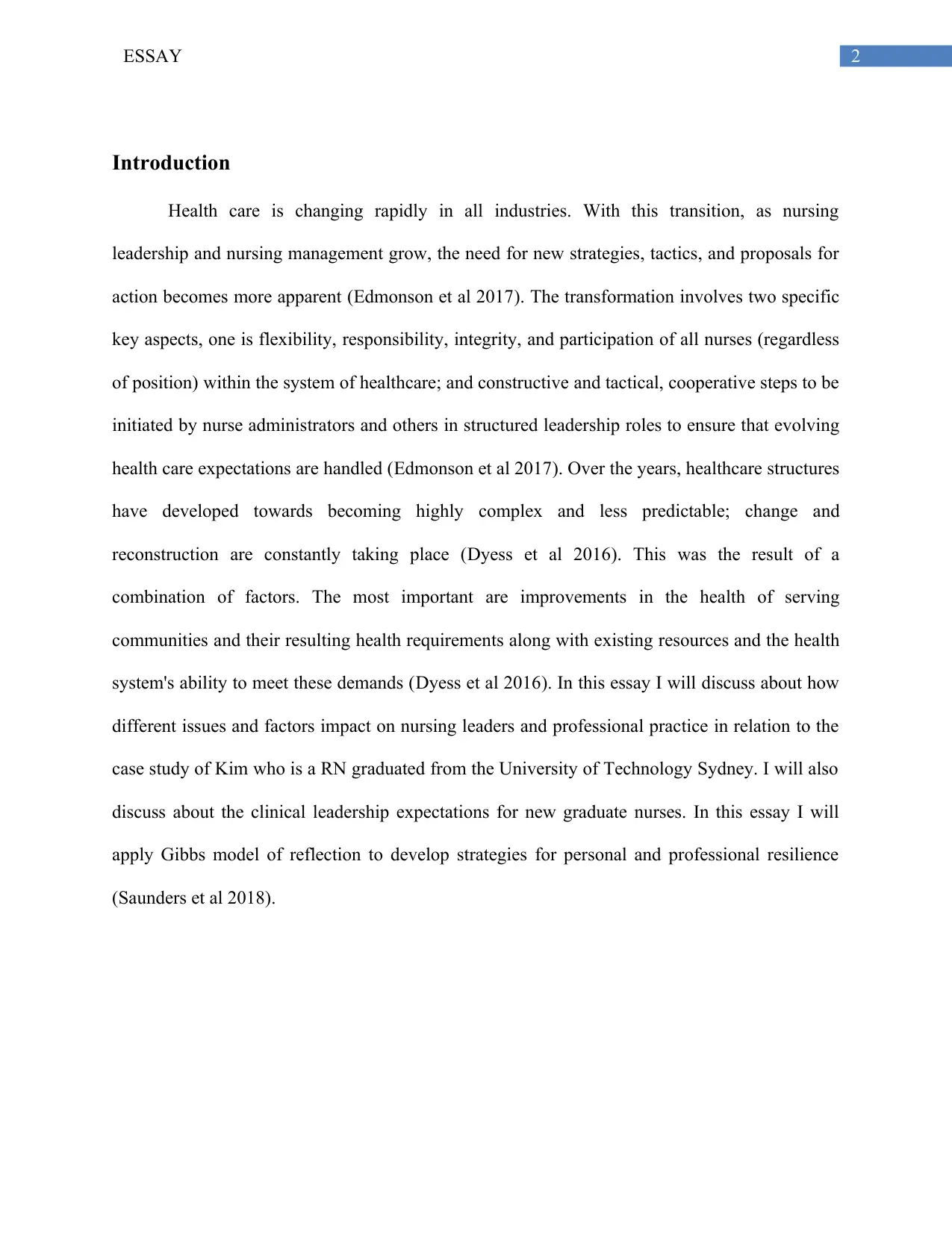
2ESSAY
Introduction
Health care is changing rapidly in all industries. With this transition, as nursing
leadership and nursing management grow, the need for new strategies, tactics, and proposals for
action becomes more apparent (Edmonson et al 2017). The transformation involves two specific
key aspects, one is flexibility, responsibility, integrity, and participation of all nurses (regardless
of position) within the system of healthcare; and constructive and tactical, cooperative steps to be
initiated by nurse administrators and others in structured leadership roles to ensure that evolving
health care expectations are handled (Edmonson et al 2017). Over the years, healthcare structures
have developed towards becoming highly complex and less predictable; change and
reconstruction are constantly taking place (Dyess et al 2016). This was the result of a
combination of factors. The most important are improvements in the health of serving
communities and their resulting health requirements along with existing resources and the health
system's ability to meet these demands (Dyess et al 2016). In this essay I will discuss about how
different issues and factors impact on nursing leaders and professional practice in relation to the
case study of Kim who is a RN graduated from the University of Technology Sydney. I will also
discuss about the clinical leadership expectations for new graduate nurses. In this essay I will
apply Gibbs model of reflection to develop strategies for personal and professional resilience
(Saunders et al 2018).
Introduction
Health care is changing rapidly in all industries. With this transition, as nursing
leadership and nursing management grow, the need for new strategies, tactics, and proposals for
action becomes more apparent (Edmonson et al 2017). The transformation involves two specific
key aspects, one is flexibility, responsibility, integrity, and participation of all nurses (regardless
of position) within the system of healthcare; and constructive and tactical, cooperative steps to be
initiated by nurse administrators and others in structured leadership roles to ensure that evolving
health care expectations are handled (Edmonson et al 2017). Over the years, healthcare structures
have developed towards becoming highly complex and less predictable; change and
reconstruction are constantly taking place (Dyess et al 2016). This was the result of a
combination of factors. The most important are improvements in the health of serving
communities and their resulting health requirements along with existing resources and the health
system's ability to meet these demands (Dyess et al 2016). In this essay I will discuss about how
different issues and factors impact on nursing leaders and professional practice in relation to the
case study of Kim who is a RN graduated from the University of Technology Sydney. I will also
discuss about the clinical leadership expectations for new graduate nurses. In this essay I will
apply Gibbs model of reflection to develop strategies for personal and professional resilience
(Saunders et al 2018).
⊘ This is a preview!⊘
Do you want full access?
Subscribe today to unlock all pages.

Trusted by 1+ million students worldwide
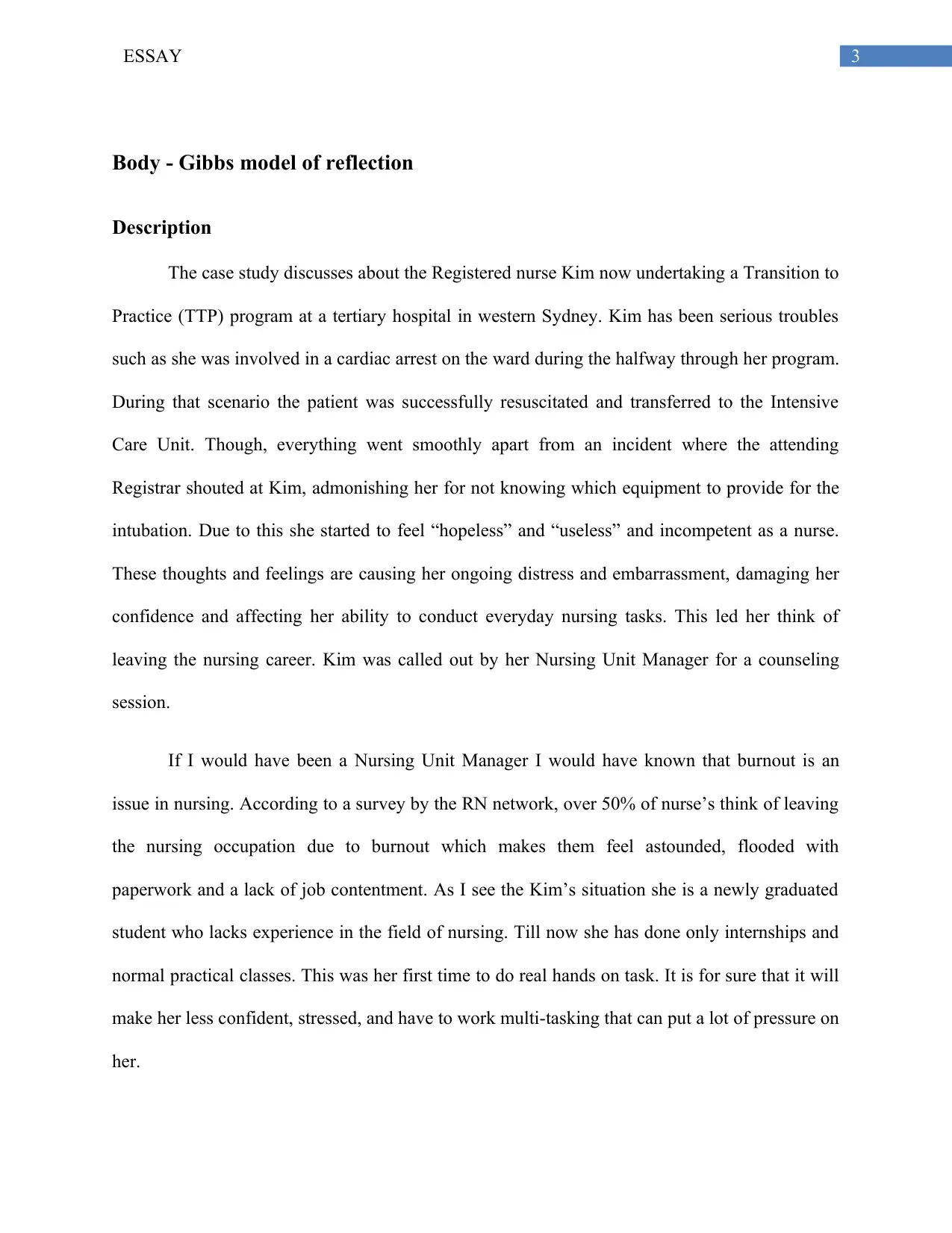
3ESSAY
Body - Gibbs model of reflection
Description
The case study discusses about the Registered nurse Kim now undertaking a Transition to
Practice (TTP) program at a tertiary hospital in western Sydney. Kim has been serious troubles
such as she was involved in a cardiac arrest on the ward during the halfway through her program.
During that scenario the patient was successfully resuscitated and transferred to the Intensive
Care Unit. Though, everything went smoothly apart from an incident where the attending
Registrar shouted at Kim, admonishing her for not knowing which equipment to provide for the
intubation. Due to this she started to feel “hopeless” and “useless” and incompetent as a nurse.
These thoughts and feelings are causing her ongoing distress and embarrassment, damaging her
confidence and affecting her ability to conduct everyday nursing tasks. This led her think of
leaving the nursing career. Kim was called out by her Nursing Unit Manager for a counseling
session.
If I would have been a Nursing Unit Manager I would have known that burnout is an
issue in nursing. According to a survey by the RN network, over 50% of nurse’s think of leaving
the nursing occupation due to burnout which makes them feel astounded, flooded with
paperwork and a lack of job contentment. As I see the Kim’s situation she is a newly graduated
student who lacks experience in the field of nursing. Till now she has done only internships and
normal practical classes. This was her first time to do real hands on task. It is for sure that it will
make her less confident, stressed, and have to work multi-tasking that can put a lot of pressure on
her.
Body - Gibbs model of reflection
Description
The case study discusses about the Registered nurse Kim now undertaking a Transition to
Practice (TTP) program at a tertiary hospital in western Sydney. Kim has been serious troubles
such as she was involved in a cardiac arrest on the ward during the halfway through her program.
During that scenario the patient was successfully resuscitated and transferred to the Intensive
Care Unit. Though, everything went smoothly apart from an incident where the attending
Registrar shouted at Kim, admonishing her for not knowing which equipment to provide for the
intubation. Due to this she started to feel “hopeless” and “useless” and incompetent as a nurse.
These thoughts and feelings are causing her ongoing distress and embarrassment, damaging her
confidence and affecting her ability to conduct everyday nursing tasks. This led her think of
leaving the nursing career. Kim was called out by her Nursing Unit Manager for a counseling
session.
If I would have been a Nursing Unit Manager I would have known that burnout is an
issue in nursing. According to a survey by the RN network, over 50% of nurse’s think of leaving
the nursing occupation due to burnout which makes them feel astounded, flooded with
paperwork and a lack of job contentment. As I see the Kim’s situation she is a newly graduated
student who lacks experience in the field of nursing. Till now she has done only internships and
normal practical classes. This was her first time to do real hands on task. It is for sure that it will
make her less confident, stressed, and have to work multi-tasking that can put a lot of pressure on
her.
Paraphrase This Document
Need a fresh take? Get an instant paraphrase of this document with our AI Paraphraser
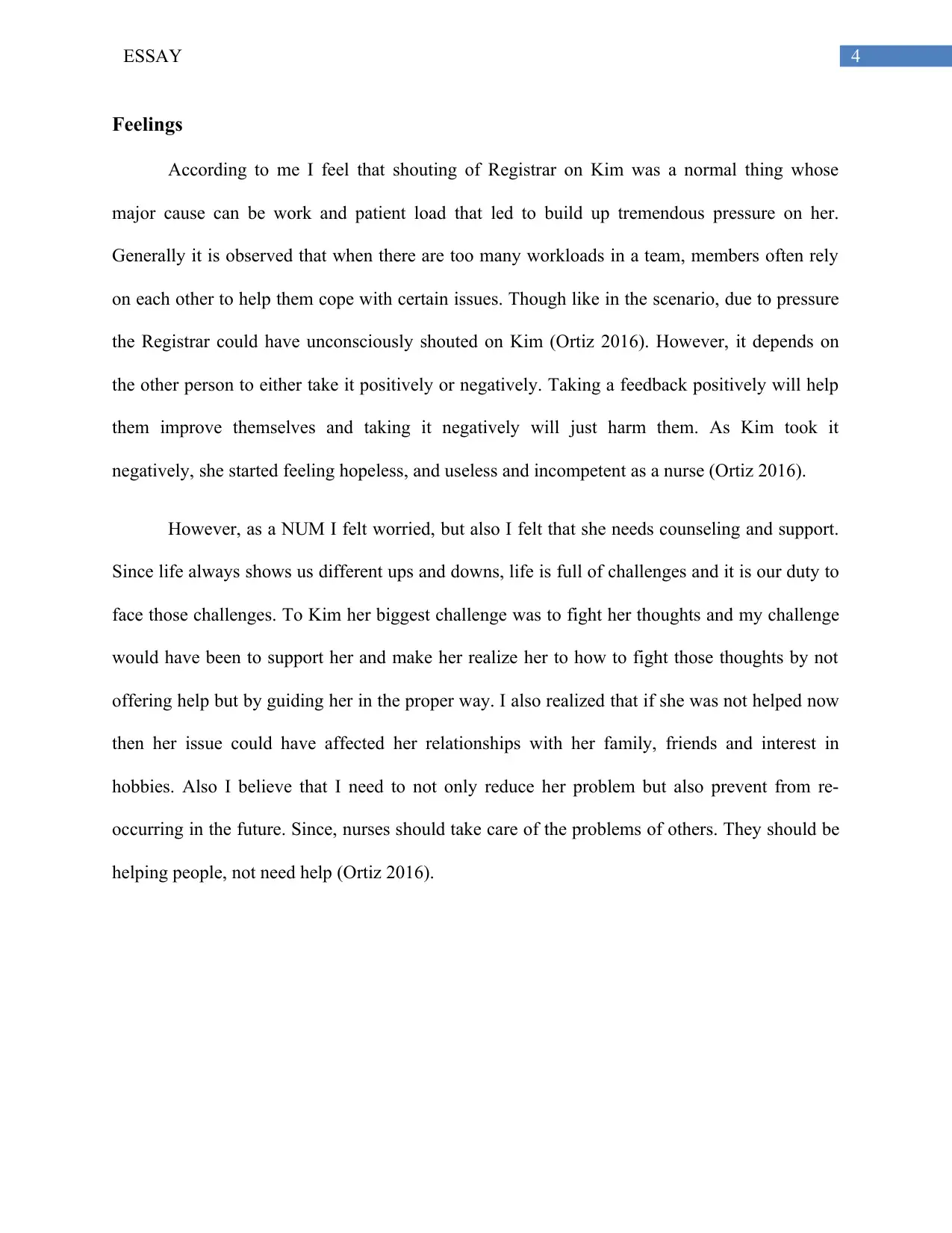
4ESSAY
Feelings
According to me I feel that shouting of Registrar on Kim was a normal thing whose
major cause can be work and patient load that led to build up tremendous pressure on her.
Generally it is observed that when there are too many workloads in a team, members often rely
on each other to help them cope with certain issues. Though like in the scenario, due to pressure
the Registrar could have unconsciously shouted on Kim (Ortiz 2016). However, it depends on
the other person to either take it positively or negatively. Taking a feedback positively will help
them improve themselves and taking it negatively will just harm them. As Kim took it
negatively, she started feeling hopeless, and useless and incompetent as a nurse (Ortiz 2016).
However, as a NUM I felt worried, but also I felt that she needs counseling and support.
Since life always shows us different ups and downs, life is full of challenges and it is our duty to
face those challenges. To Kim her biggest challenge was to fight her thoughts and my challenge
would have been to support her and make her realize her to how to fight those thoughts by not
offering help but by guiding her in the proper way. I also realized that if she was not helped now
then her issue could have affected her relationships with her family, friends and interest in
hobbies. Also I believe that I need to not only reduce her problem but also prevent from re-
occurring in the future. Since, nurses should take care of the problems of others. They should be
helping people, not need help (Ortiz 2016).
Feelings
According to me I feel that shouting of Registrar on Kim was a normal thing whose
major cause can be work and patient load that led to build up tremendous pressure on her.
Generally it is observed that when there are too many workloads in a team, members often rely
on each other to help them cope with certain issues. Though like in the scenario, due to pressure
the Registrar could have unconsciously shouted on Kim (Ortiz 2016). However, it depends on
the other person to either take it positively or negatively. Taking a feedback positively will help
them improve themselves and taking it negatively will just harm them. As Kim took it
negatively, she started feeling hopeless, and useless and incompetent as a nurse (Ortiz 2016).
However, as a NUM I felt worried, but also I felt that she needs counseling and support.
Since life always shows us different ups and downs, life is full of challenges and it is our duty to
face those challenges. To Kim her biggest challenge was to fight her thoughts and my challenge
would have been to support her and make her realize her to how to fight those thoughts by not
offering help but by guiding her in the proper way. I also realized that if she was not helped now
then her issue could have affected her relationships with her family, friends and interest in
hobbies. Also I believe that I need to not only reduce her problem but also prevent from re-
occurring in the future. Since, nurses should take care of the problems of others. They should be
helping people, not need help (Ortiz 2016).
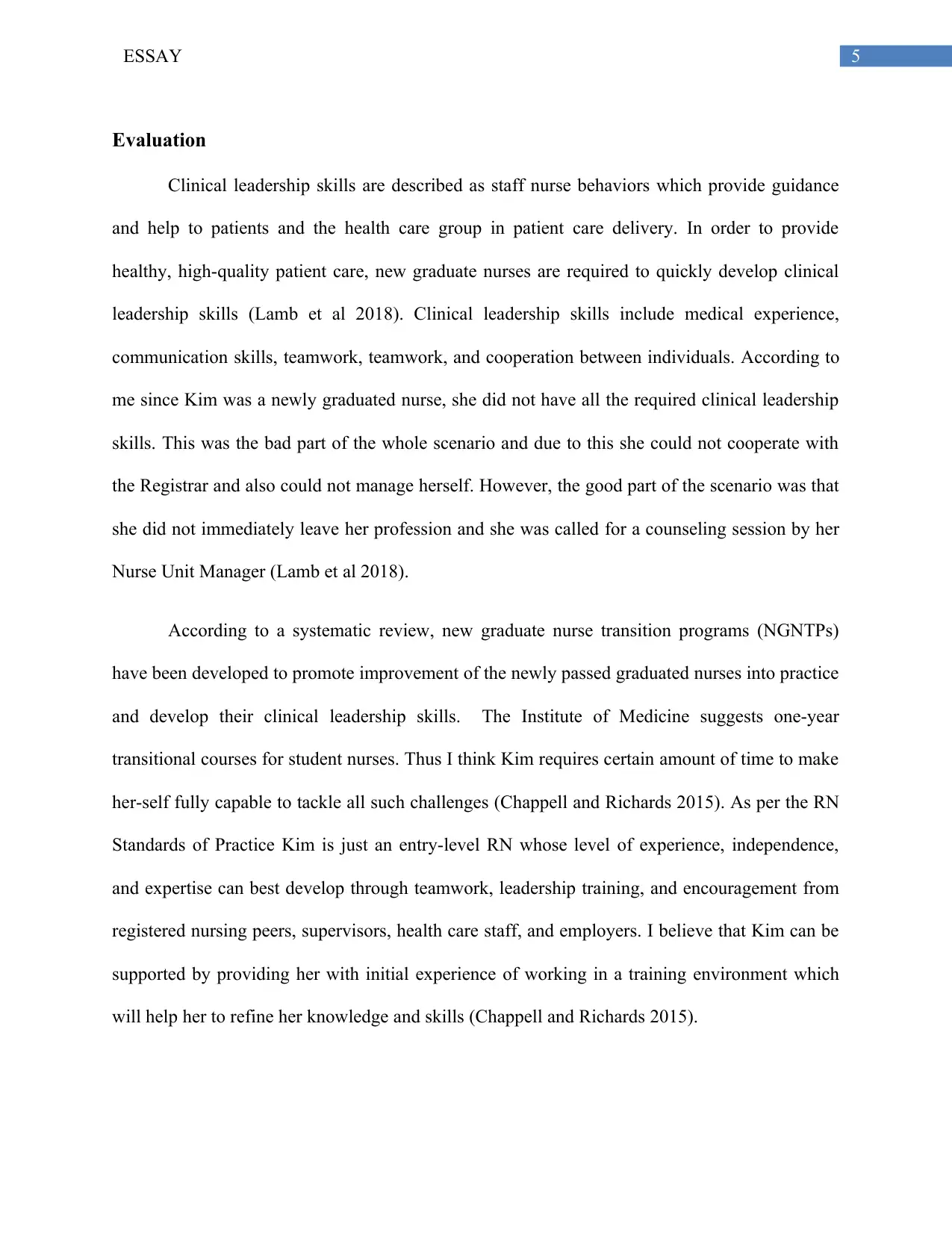
5ESSAY
Evaluation
Clinical leadership skills are described as staff nurse behaviors which provide guidance
and help to patients and the health care group in patient care delivery. In order to provide
healthy, high-quality patient care, new graduate nurses are required to quickly develop clinical
leadership skills (Lamb et al 2018). Clinical leadership skills include medical experience,
communication skills, teamwork, teamwork, and cooperation between individuals. According to
me since Kim was a newly graduated nurse, she did not have all the required clinical leadership
skills. This was the bad part of the whole scenario and due to this she could not cooperate with
the Registrar and also could not manage herself. However, the good part of the scenario was that
she did not immediately leave her profession and she was called for a counseling session by her
Nurse Unit Manager (Lamb et al 2018).
According to a systematic review, new graduate nurse transition programs (NGNTPs)
have been developed to promote improvement of the newly passed graduated nurses into practice
and develop their clinical leadership skills. The Institute of Medicine suggests one-year
transitional courses for student nurses. Thus I think Kim requires certain amount of time to make
her-self fully capable to tackle all such challenges (Chappell and Richards 2015). As per the RN
Standards of Practice Kim is just an entry-level RN whose level of experience, independence,
and expertise can best develop through teamwork, leadership training, and encouragement from
registered nursing peers, supervisors, health care staff, and employers. I believe that Kim can be
supported by providing her with initial experience of working in a training environment which
will help her to refine her knowledge and skills (Chappell and Richards 2015).
Evaluation
Clinical leadership skills are described as staff nurse behaviors which provide guidance
and help to patients and the health care group in patient care delivery. In order to provide
healthy, high-quality patient care, new graduate nurses are required to quickly develop clinical
leadership skills (Lamb et al 2018). Clinical leadership skills include medical experience,
communication skills, teamwork, teamwork, and cooperation between individuals. According to
me since Kim was a newly graduated nurse, she did not have all the required clinical leadership
skills. This was the bad part of the whole scenario and due to this she could not cooperate with
the Registrar and also could not manage herself. However, the good part of the scenario was that
she did not immediately leave her profession and she was called for a counseling session by her
Nurse Unit Manager (Lamb et al 2018).
According to a systematic review, new graduate nurse transition programs (NGNTPs)
have been developed to promote improvement of the newly passed graduated nurses into practice
and develop their clinical leadership skills. The Institute of Medicine suggests one-year
transitional courses for student nurses. Thus I think Kim requires certain amount of time to make
her-self fully capable to tackle all such challenges (Chappell and Richards 2015). As per the RN
Standards of Practice Kim is just an entry-level RN whose level of experience, independence,
and expertise can best develop through teamwork, leadership training, and encouragement from
registered nursing peers, supervisors, health care staff, and employers. I believe that Kim can be
supported by providing her with initial experience of working in a training environment which
will help her to refine her knowledge and skills (Chappell and Richards 2015).
⊘ This is a preview!⊘
Do you want full access?
Subscribe today to unlock all pages.

Trusted by 1+ million students worldwide
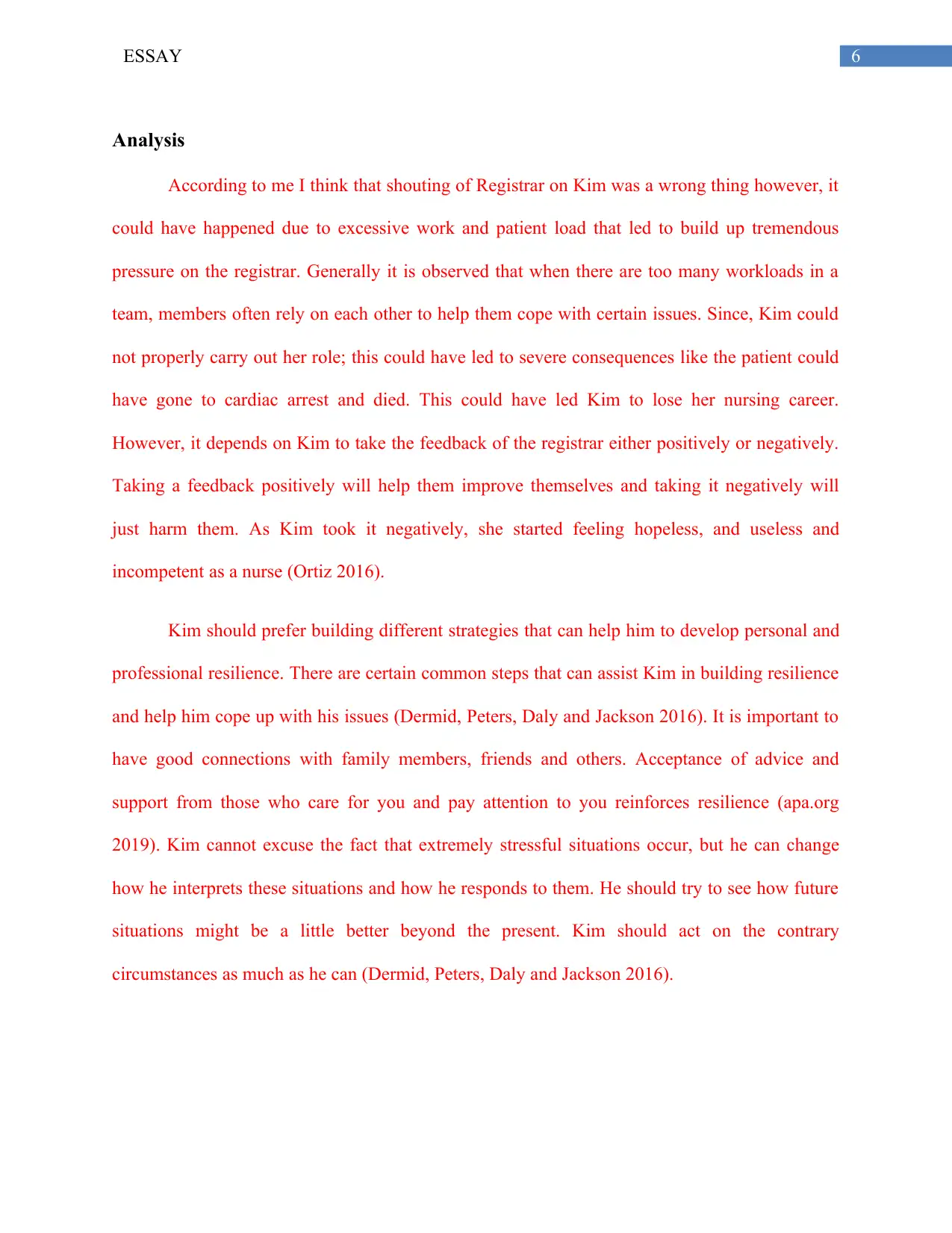
6ESSAY
Analysis
According to me I think that shouting of Registrar on Kim was a wrong thing however, it
could have happened due to excessive work and patient load that led to build up tremendous
pressure on the registrar. Generally it is observed that when there are too many workloads in a
team, members often rely on each other to help them cope with certain issues. Since, Kim could
not properly carry out her role; this could have led to severe consequences like the patient could
have gone to cardiac arrest and died. This could have led Kim to lose her nursing career.
However, it depends on Kim to take the feedback of the registrar either positively or negatively.
Taking a feedback positively will help them improve themselves and taking it negatively will
just harm them. As Kim took it negatively, she started feeling hopeless, and useless and
incompetent as a nurse (Ortiz 2016).
Kim should prefer building different strategies that can help him to develop personal and
professional resilience. There are certain common steps that can assist Kim in building resilience
and help him cope up with his issues (Dermid, Peters, Daly and Jackson 2016). It is important to
have good connections with family members, friends and others. Acceptance of advice and
support from those who care for you and pay attention to you reinforces resilience (apa.org
2019). Kim cannot excuse the fact that extremely stressful situations occur, but he can change
how he interprets these situations and how he responds to them. He should try to see how future
situations might be a little better beyond the present. Kim should act on the contrary
circumstances as much as he can (Dermid, Peters, Daly and Jackson 2016).
Analysis
According to me I think that shouting of Registrar on Kim was a wrong thing however, it
could have happened due to excessive work and patient load that led to build up tremendous
pressure on the registrar. Generally it is observed that when there are too many workloads in a
team, members often rely on each other to help them cope with certain issues. Since, Kim could
not properly carry out her role; this could have led to severe consequences like the patient could
have gone to cardiac arrest and died. This could have led Kim to lose her nursing career.
However, it depends on Kim to take the feedback of the registrar either positively or negatively.
Taking a feedback positively will help them improve themselves and taking it negatively will
just harm them. As Kim took it negatively, she started feeling hopeless, and useless and
incompetent as a nurse (Ortiz 2016).
Kim should prefer building different strategies that can help him to develop personal and
professional resilience. There are certain common steps that can assist Kim in building resilience
and help him cope up with his issues (Dermid, Peters, Daly and Jackson 2016). It is important to
have good connections with family members, friends and others. Acceptance of advice and
support from those who care for you and pay attention to you reinforces resilience (apa.org
2019). Kim cannot excuse the fact that extremely stressful situations occur, but he can change
how he interprets these situations and how he responds to them. He should try to see how future
situations might be a little better beyond the present. Kim should act on the contrary
circumstances as much as he can (Dermid, Peters, Daly and Jackson 2016).
Paraphrase This Document
Need a fresh take? Get an instant paraphrase of this document with our AI Paraphraser
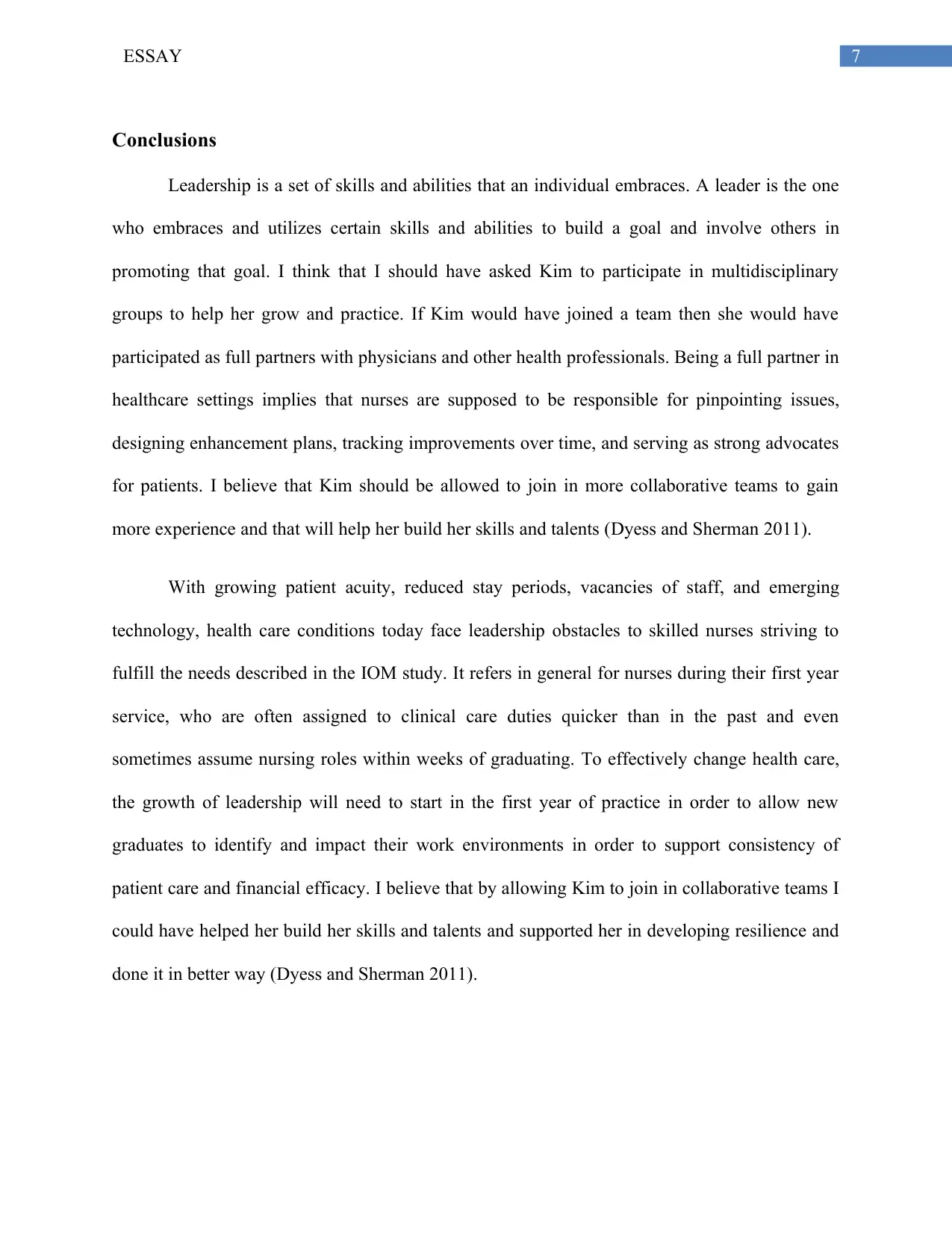
7ESSAY
Conclusions
Leadership is a set of skills and abilities that an individual embraces. A leader is the one
who embraces and utilizes certain skills and abilities to build a goal and involve others in
promoting that goal. I think that I should have asked Kim to participate in multidisciplinary
groups to help her grow and practice. If Kim would have joined a team then she would have
participated as full partners with physicians and other health professionals. Being a full partner in
healthcare settings implies that nurses are supposed to be responsible for pinpointing issues,
designing enhancement plans, tracking improvements over time, and serving as strong advocates
for patients. I believe that Kim should be allowed to join in more collaborative teams to gain
more experience and that will help her build her skills and talents (Dyess and Sherman 2011).
With growing patient acuity, reduced stay periods, vacancies of staff, and emerging
technology, health care conditions today face leadership obstacles to skilled nurses striving to
fulfill the needs described in the IOM study. It refers in general for nurses during their first year
service, who are often assigned to clinical care duties quicker than in the past and even
sometimes assume nursing roles within weeks of graduating. To effectively change health care,
the growth of leadership will need to start in the first year of practice in order to allow new
graduates to identify and impact their work environments in order to support consistency of
patient care and financial efficacy. I believe that by allowing Kim to join in collaborative teams I
could have helped her build her skills and talents and supported her in developing resilience and
done it in better way (Dyess and Sherman 2011).
Conclusions
Leadership is a set of skills and abilities that an individual embraces. A leader is the one
who embraces and utilizes certain skills and abilities to build a goal and involve others in
promoting that goal. I think that I should have asked Kim to participate in multidisciplinary
groups to help her grow and practice. If Kim would have joined a team then she would have
participated as full partners with physicians and other health professionals. Being a full partner in
healthcare settings implies that nurses are supposed to be responsible for pinpointing issues,
designing enhancement plans, tracking improvements over time, and serving as strong advocates
for patients. I believe that Kim should be allowed to join in more collaborative teams to gain
more experience and that will help her build her skills and talents (Dyess and Sherman 2011).
With growing patient acuity, reduced stay periods, vacancies of staff, and emerging
technology, health care conditions today face leadership obstacles to skilled nurses striving to
fulfill the needs described in the IOM study. It refers in general for nurses during their first year
service, who are often assigned to clinical care duties quicker than in the past and even
sometimes assume nursing roles within weeks of graduating. To effectively change health care,
the growth of leadership will need to start in the first year of practice in order to allow new
graduates to identify and impact their work environments in order to support consistency of
patient care and financial efficacy. I believe that by allowing Kim to join in collaborative teams I
could have helped her build her skills and talents and supported her in developing resilience and
done it in better way (Dyess and Sherman 2011).
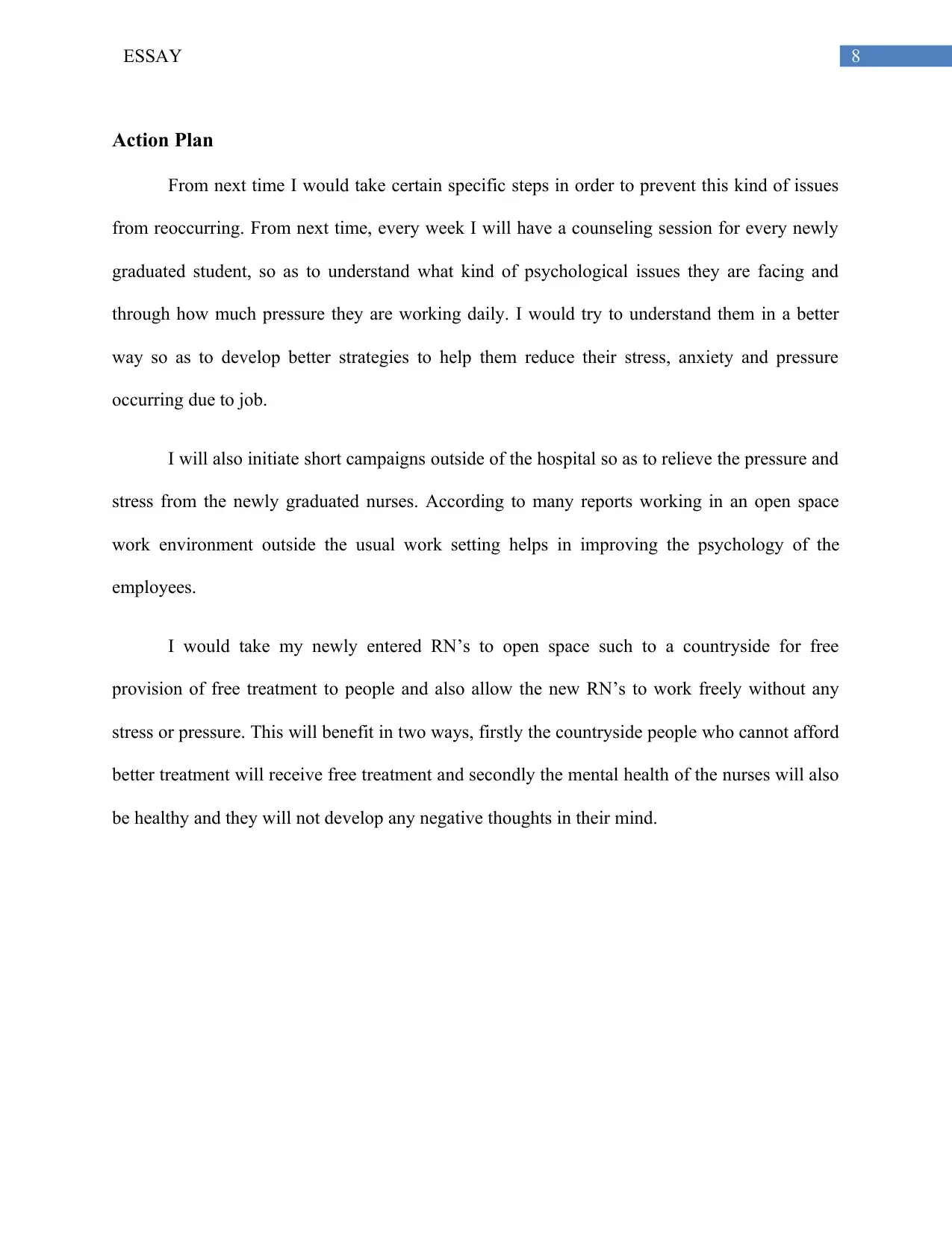
8ESSAY
Action Plan
From next time I would take certain specific steps in order to prevent this kind of issues
from reoccurring. From next time, every week I will have a counseling session for every newly
graduated student, so as to understand what kind of psychological issues they are facing and
through how much pressure they are working daily. I would try to understand them in a better
way so as to develop better strategies to help them reduce their stress, anxiety and pressure
occurring due to job.
I will also initiate short campaigns outside of the hospital so as to relieve the pressure and
stress from the newly graduated nurses. According to many reports working in an open space
work environment outside the usual work setting helps in improving the psychology of the
employees.
I would take my newly entered RN’s to open space such to a countryside for free
provision of free treatment to people and also allow the new RN’s to work freely without any
stress or pressure. This will benefit in two ways, firstly the countryside people who cannot afford
better treatment will receive free treatment and secondly the mental health of the nurses will also
be healthy and they will not develop any negative thoughts in their mind.
Action Plan
From next time I would take certain specific steps in order to prevent this kind of issues
from reoccurring. From next time, every week I will have a counseling session for every newly
graduated student, so as to understand what kind of psychological issues they are facing and
through how much pressure they are working daily. I would try to understand them in a better
way so as to develop better strategies to help them reduce their stress, anxiety and pressure
occurring due to job.
I will also initiate short campaigns outside of the hospital so as to relieve the pressure and
stress from the newly graduated nurses. According to many reports working in an open space
work environment outside the usual work setting helps in improving the psychology of the
employees.
I would take my newly entered RN’s to open space such to a countryside for free
provision of free treatment to people and also allow the new RN’s to work freely without any
stress or pressure. This will benefit in two ways, firstly the countryside people who cannot afford
better treatment will receive free treatment and secondly the mental health of the nurses will also
be healthy and they will not develop any negative thoughts in their mind.
⊘ This is a preview!⊘
Do you want full access?
Subscribe today to unlock all pages.

Trusted by 1+ million students worldwide
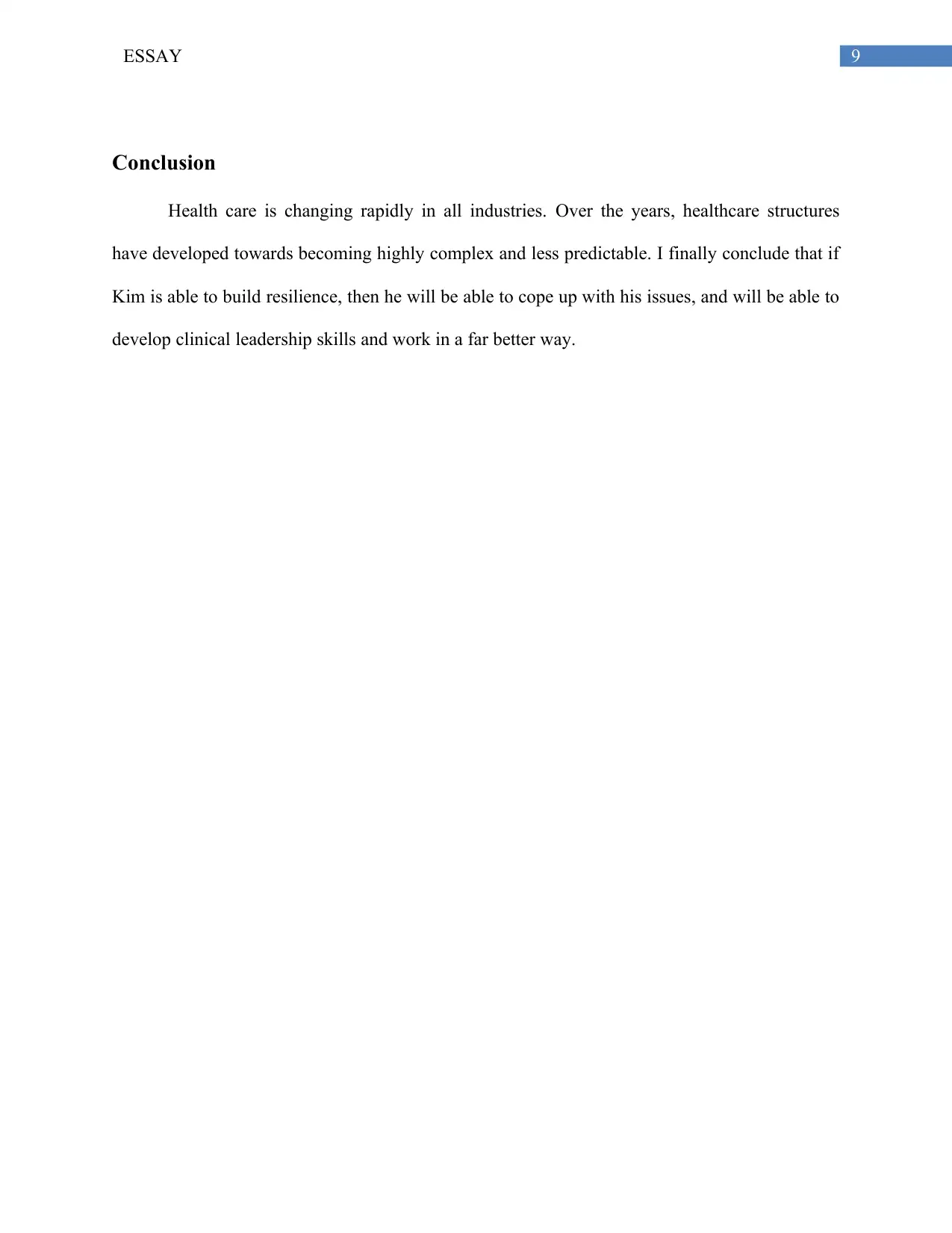
9ESSAY
Conclusion
Health care is changing rapidly in all industries. Over the years, healthcare structures
have developed towards becoming highly complex and less predictable. I finally conclude that if
Kim is able to build resilience, then he will be able to cope up with his issues, and will be able to
develop clinical leadership skills and work in a far better way.
Conclusion
Health care is changing rapidly in all industries. Over the years, healthcare structures
have developed towards becoming highly complex and less predictable. I finally conclude that if
Kim is able to build resilience, then he will be able to cope up with his issues, and will be able to
develop clinical leadership skills and work in a far better way.
Paraphrase This Document
Need a fresh take? Get an instant paraphrase of this document with our AI Paraphraser
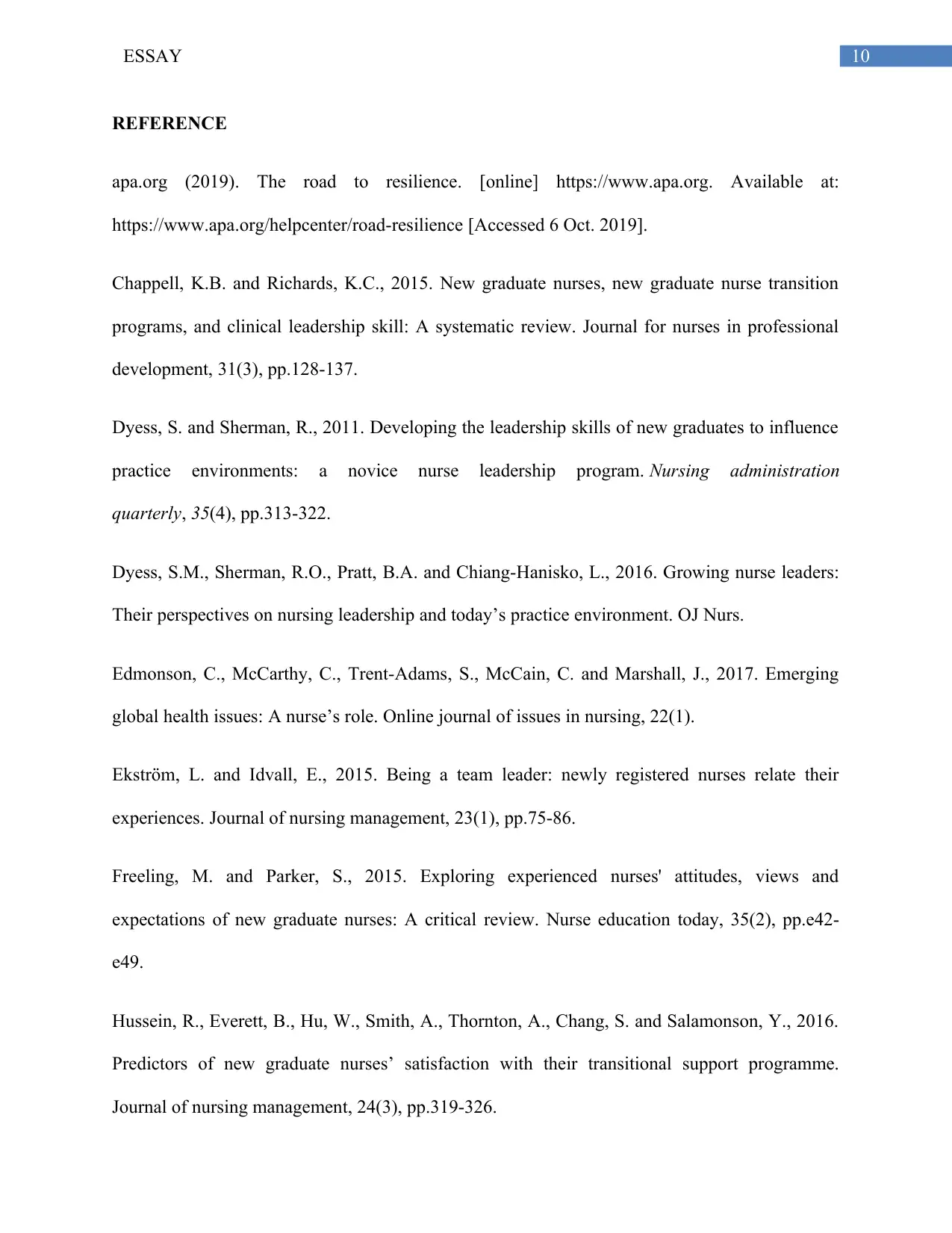
10ESSAY
REFERENCE
apa.org (2019). The road to resilience. [online] https://www.apa.org. Available at:
https://www.apa.org/helpcenter/road-resilience [Accessed 6 Oct. 2019].
Chappell, K.B. and Richards, K.C., 2015. New graduate nurses, new graduate nurse transition
programs, and clinical leadership skill: A systematic review. Journal for nurses in professional
development, 31(3), pp.128-137.
Dyess, S. and Sherman, R., 2011. Developing the leadership skills of new graduates to influence
practice environments: a novice nurse leadership program. Nursing administration
quarterly, 35(4), pp.313-322.
Dyess, S.M., Sherman, R.O., Pratt, B.A. and Chiang-Hanisko, L., 2016. Growing nurse leaders:
Their perspectives on nursing leadership and today’s practice environment. OJ Nurs.
Edmonson, C., McCarthy, C., Trent-Adams, S., McCain, C. and Marshall, J., 2017. Emerging
global health issues: A nurse’s role. Online journal of issues in nursing, 22(1).
Ekström, L. and Idvall, E., 2015. Being a team leader: newly registered nurses relate their
experiences. Journal of nursing management, 23(1), pp.75-86.
Freeling, M. and Parker, S., 2015. Exploring experienced nurses' attitudes, views and
expectations of new graduate nurses: A critical review. Nurse education today, 35(2), pp.e42-
e49.
Hussein, R., Everett, B., Hu, W., Smith, A., Thornton, A., Chang, S. and Salamonson, Y., 2016.
Predictors of new graduate nurses’ satisfaction with their transitional support programme.
Journal of nursing management, 24(3), pp.319-326.
REFERENCE
apa.org (2019). The road to resilience. [online] https://www.apa.org. Available at:
https://www.apa.org/helpcenter/road-resilience [Accessed 6 Oct. 2019].
Chappell, K.B. and Richards, K.C., 2015. New graduate nurses, new graduate nurse transition
programs, and clinical leadership skill: A systematic review. Journal for nurses in professional
development, 31(3), pp.128-137.
Dyess, S. and Sherman, R., 2011. Developing the leadership skills of new graduates to influence
practice environments: a novice nurse leadership program. Nursing administration
quarterly, 35(4), pp.313-322.
Dyess, S.M., Sherman, R.O., Pratt, B.A. and Chiang-Hanisko, L., 2016. Growing nurse leaders:
Their perspectives on nursing leadership and today’s practice environment. OJ Nurs.
Edmonson, C., McCarthy, C., Trent-Adams, S., McCain, C. and Marshall, J., 2017. Emerging
global health issues: A nurse’s role. Online journal of issues in nursing, 22(1).
Ekström, L. and Idvall, E., 2015. Being a team leader: newly registered nurses relate their
experiences. Journal of nursing management, 23(1), pp.75-86.
Freeling, M. and Parker, S., 2015. Exploring experienced nurses' attitudes, views and
expectations of new graduate nurses: A critical review. Nurse education today, 35(2), pp.e42-
e49.
Hussein, R., Everett, B., Hu, W., Smith, A., Thornton, A., Chang, S. and Salamonson, Y., 2016.
Predictors of new graduate nurses’ satisfaction with their transitional support programme.
Journal of nursing management, 24(3), pp.319-326.
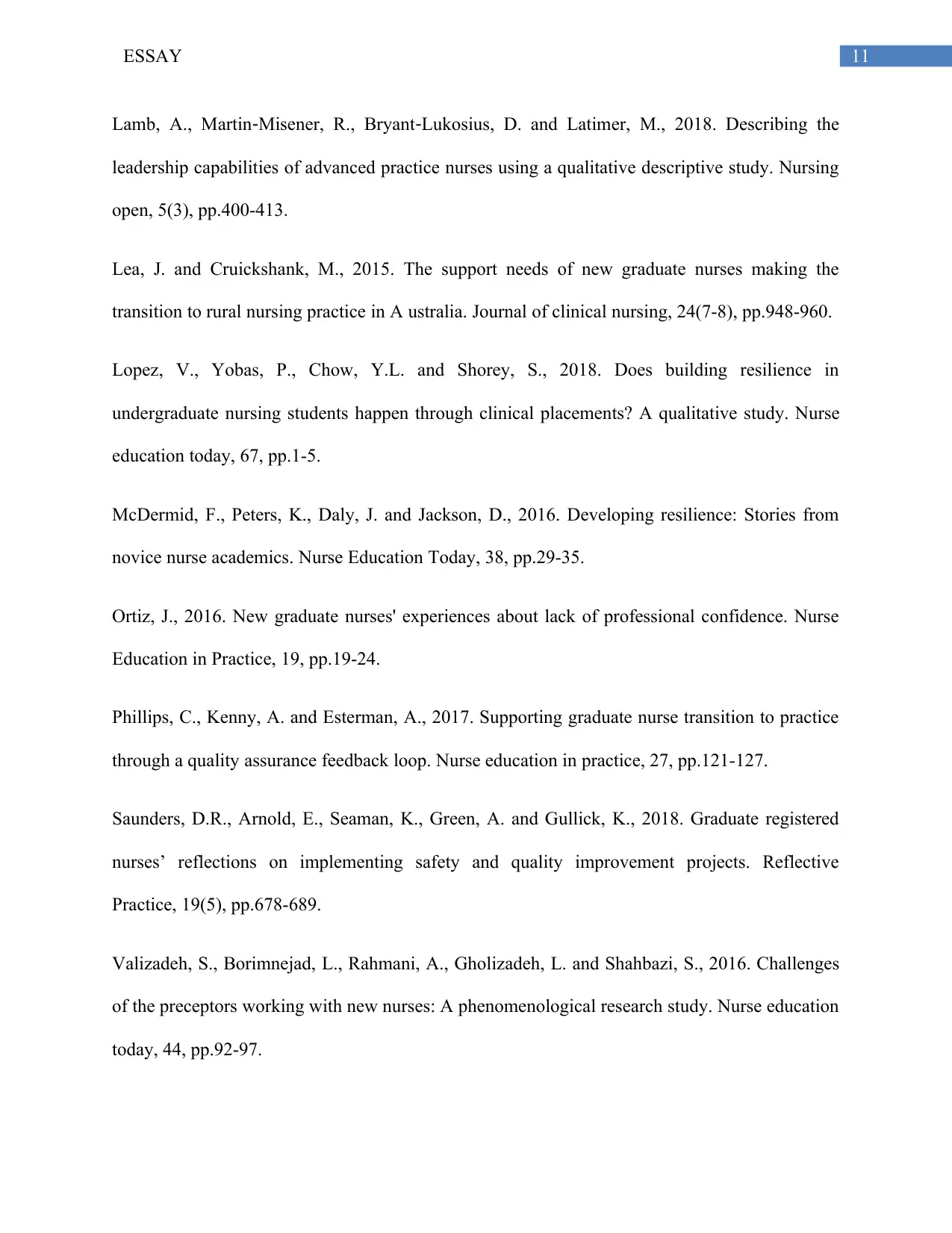
11ESSAY
Lamb, A., Martin‐Misener, R., Bryant‐Lukosius, D. and Latimer, M., 2018. Describing the
leadership capabilities of advanced practice nurses using a qualitative descriptive study. Nursing
open, 5(3), pp.400-413.
Lea, J. and Cruickshank, M., 2015. The support needs of new graduate nurses making the
transition to rural nursing practice in A ustralia. Journal of clinical nursing, 24(7-8), pp.948-960.
Lopez, V., Yobas, P., Chow, Y.L. and Shorey, S., 2018. Does building resilience in
undergraduate nursing students happen through clinical placements? A qualitative study. Nurse
education today, 67, pp.1-5.
McDermid, F., Peters, K., Daly, J. and Jackson, D., 2016. Developing resilience: Stories from
novice nurse academics. Nurse Education Today, 38, pp.29-35.
Ortiz, J., 2016. New graduate nurses' experiences about lack of professional confidence. Nurse
Education in Practice, 19, pp.19-24.
Phillips, C., Kenny, A. and Esterman, A., 2017. Supporting graduate nurse transition to practice
through a quality assurance feedback loop. Nurse education in practice, 27, pp.121-127.
Saunders, D.R., Arnold, E., Seaman, K., Green, A. and Gullick, K., 2018. Graduate registered
nurses’ reflections on implementing safety and quality improvement projects. Reflective
Practice, 19(5), pp.678-689.
Valizadeh, S., Borimnejad, L., Rahmani, A., Gholizadeh, L. and Shahbazi, S., 2016. Challenges
of the preceptors working with new nurses: A phenomenological research study. Nurse education
today, 44, pp.92-97.
Lamb, A., Martin‐Misener, R., Bryant‐Lukosius, D. and Latimer, M., 2018. Describing the
leadership capabilities of advanced practice nurses using a qualitative descriptive study. Nursing
open, 5(3), pp.400-413.
Lea, J. and Cruickshank, M., 2015. The support needs of new graduate nurses making the
transition to rural nursing practice in A ustralia. Journal of clinical nursing, 24(7-8), pp.948-960.
Lopez, V., Yobas, P., Chow, Y.L. and Shorey, S., 2018. Does building resilience in
undergraduate nursing students happen through clinical placements? A qualitative study. Nurse
education today, 67, pp.1-5.
McDermid, F., Peters, K., Daly, J. and Jackson, D., 2016. Developing resilience: Stories from
novice nurse academics. Nurse Education Today, 38, pp.29-35.
Ortiz, J., 2016. New graduate nurses' experiences about lack of professional confidence. Nurse
Education in Practice, 19, pp.19-24.
Phillips, C., Kenny, A. and Esterman, A., 2017. Supporting graduate nurse transition to practice
through a quality assurance feedback loop. Nurse education in practice, 27, pp.121-127.
Saunders, D.R., Arnold, E., Seaman, K., Green, A. and Gullick, K., 2018. Graduate registered
nurses’ reflections on implementing safety and quality improvement projects. Reflective
Practice, 19(5), pp.678-689.
Valizadeh, S., Borimnejad, L., Rahmani, A., Gholizadeh, L. and Shahbazi, S., 2016. Challenges
of the preceptors working with new nurses: A phenomenological research study. Nurse education
today, 44, pp.92-97.
⊘ This is a preview!⊘
Do you want full access?
Subscribe today to unlock all pages.

Trusted by 1+ million students worldwide
1 out of 14
Related Documents
Your All-in-One AI-Powered Toolkit for Academic Success.
+13062052269
info@desklib.com
Available 24*7 on WhatsApp / Email
![[object Object]](/_next/static/media/star-bottom.7253800d.svg)
Unlock your academic potential
Copyright © 2020–2025 A2Z Services. All Rights Reserved. Developed and managed by ZUCOL.





